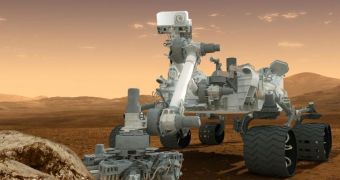Mars Science Laboratory (MSL) mission managers at the NASA Jet Propulsion Laboratory (JPL), in Pasadena, California, announce that a new flight path correction maneuver was successfully conducted on Tuesday, June 26, and that the spacecraft is currently on the correct path for its Martian landing.
Current predictions estimate that the MSL will deploy its rover, called Curiosity, on the slopes of Mount Sharp, inside Gale Crater, on August 6. Recently, scientists refined the landing ellipse for the mission, and the new flight correction maneuver reflected these changes.
The thrusters on the MSL aeroshell fired for a total of 40 seconds, changing the point where the vehicle will make contact with the Martian atmosphere by about 125 miles (200 kilometers), and moving the time of landing ahead by 70 seconds.
This was the third and smallest flight path correction maneuver conducted since November 26, 2011, when the 1-ton rover was launched. Curiosity is the largest exploration robot ever to be sent on another world. It is about the size of a Mini Cooper, its engineers explain.
JPL experts say that the nuclear-powered rover will spend at least two years investigating the exposed rock layers inside Gale Crater. If the machine is able to endure the harsh Martian conditions like its predecessors were, then the mission may extend well beyond that time.
The new correction “puts us closer to our entry target, so if any further maneuvers are needed, I expect them to be small,” explains the chief of the JPL MSL navigation team, Tomas Martin-Mur. During the final week of flight, experts scheduled three additional correction maneuver opportunities.
Telemetry data from the spacecraft and Doppler shifts in its radio signals confirmed that the new path was taken. Now, Curiosity will land 4 miles (7 kilometers) closer to Mount Sharp than originally planned, shaving several months of driving in the process, and boosting the mission's scientific return.
“In the next 40 days, the flight team will be laser-focused on the preparations for the challenging events of landing day – continuously tracking the spacecraft's trajectory and monitoring the health and performance of its onboard systems, while using NASA's Deep Space Network to stay in continuous communications,” Arthur Amador said.
“We're in the home stretch now. The spacecraft continues to perform very well. And the flight team is up for the challenge,” concluded the expert, who is the MSL mission manager at JPL.

 14 DAY TRIAL //
14 DAY TRIAL //